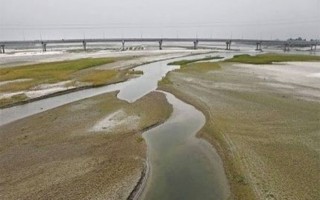Teesta flow continues to fall
The Teesta flow has continued to fall since January because of the unilateral withdrawal of water upstream in India in the absence of any deal on the sharing of water of the common river between Bangladesh and India.
The average flow of water in the trans-boundary river at Dalia point in Nilphamari went down to 1823 cusecs in the last 10 days of February from an average flow of 4,316 cusecs recorded in the first 10 days of December 2016, said Water Development Board officials.
The drastic fall of water in the river Teesta is having adverse impacts on lives and livelihoods in Bangladesh’s northern districts, according to local people.
The water flow at Dalia point abruptly fell to 2,232 cusecs on January 9 from over 4,000 cusecs in December 2016, the officials said.
The average water flow was recorded 1913 cusecs in the first 10 days of March, marking a slight rise due to rainfalls, they added.
‘We expect a positive outcome during our prime minister Sheikh Hasina’s visit to India early next month as regards to all outstanding issues including signing of Teesta deal,’ state minister for water resources Muhammad Nazrul Islam told New Age on Sunday.
He said that Dhaka would give priority to the singing of the much-hyped Teesta water sharing deal among other issues as Indian prime minister Narendra Modi and his predecessor assured Bangladesh of it earlier.
Referring the Ganges water sharing treaty with India, he said that such an agreement was necessary for Bangladesh to ensure equitable share of the Teesta water as thousands of people in northern districts depended on the river for their livelihoods.
About the sudden fall in the Teesta water level, the state minister said that the situation was better so far in comparison with the previous years.
Bangladesh has long been pushing for signing the proposed deal so that its rightful share of water is guaranteed for ‘the Teesta Barrage project, biodiversity in the area and also for the existence of the river itself.’
The flow of water in the river fell to 2,768 cusecs on an average in the first 10 days of January against the historical average flow of 7,010 cusecs during the period from 1973 to 1985, a senior official at the Joint Rivers Commission, Bangladesh said.
A draft of the deal was finalised earlier through a series of meetings and consultations between the two countries, said a senior commission official.
The official said that the sudden fall in the flow caused severe adverse impact on the agro-socio-economic conditions in the Teesta dependent areas in Bangladesh.
India withdraws water from various points of the cross-border river, particularly in the lean season in February-March, allowing a little amount to flow into Bangladesh that it cannot manage upstream, said officials.
The signing of the much-awaited Teesta water sharing deal was dropped at the eleventh hour during former Indian prime minister Manmohan Singh’s visit to Dhaka in 2011, apparently following West Bengal chief minister Mamata Banerjee’s objection.
Although the two neighbours share 54 trans-boundary rivers, the countries have an agreement only on Ganges water sharing.
India and Bangladesh earlier had exchanged drafts of an interim agreement on the principles of sharing water of Teesta that entered Bangladesh through Nilphamari border and flowed across the northern division, Rangpur.
The flow in the cross-border river fell to about 300 cusecs in February 2015 that played havoc with biodiversity and agriculture in Bangladesh’s north.
Over seven lakh hectares of cultivable land in the country’s north depend on the Teesta water for irrigation during the lean season.
- See more at: http://www.newagebd.net/article/11082/teesta-flow-continues-to-fall#sthash.QQmgt3nT.dpuf











